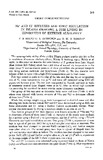| dc.contributor.author | Eddy, FB | |
| dc.contributor.author | Bamford, OS | |
| dc.contributor.author | Maloiy, GMO | |
| dc.date.accessioned | 2013-07-22T09:32:29Z | |
| dc.date.available | 2013-07-22T09:32:29Z | |
| dc.date.issued | 1981 | |
| dc.identifier.citation | J. exp. Biol. (1981), 91, 349-353 | en |
| dc.identifier.uri | http://jeb.biologists.org/content/91/1/349.short | |
| dc.identifier.uri | http://erepository.uonbi.ac.ke:8080/xmlui/handle/123456789/49616 | |
| dc.description.abstract | The osmoregularity ability of the cichlid Tilapia grahami enables this fish to live
in conditions of extreme alkalinity (Reite, Maloiy & Aashaug, 1974; Maloiy et al.
1978). In this paper we describe the ionic balance of T. grahami from Lake Magadi
(East African Rift Valley) which has a pH value of around 10, temperature in the
range 30-40 °C and an osmotic pressure of about 500 mOsm, the principal inorganic
ions being sodium carbonate and bicarbonate (Table 1). We also describe ionic
balance of fish in water with a high NaCl concentration and in fresh water.
Fish were netted in pools at the edge of the lake and that day the air temperature
was 26 °C, water temperature was 30 °C and water pH estimated using BDH pH
papers was between 9-10. The fish were transported to Nairobi and kept in tanks
of constantly aerated Lake Magadi water at 20 °C. After an initial high mortality
the remaining fish survived for many months under laboratory conditions.
One group of fish was used to determine body water and ions (Table 1) while
others were injected with known amounts of
22Na and MC1 to determine effluxes of these ions (Table 2). | en |
| dc.language.iso | en | en |
| dc.title | Na+ AND Cl~ EFFLUXES AND IONIC REGULATION IN TILAPIA GRAHAMI, A FISH LIVING IN CONDITIONS OF EXTREME ALKALINITY | en |
| dc.type | Article | en |
| local.publisher | Department of Biological Sciences, The University, Dundee DDi 4HN, U.K. | en |
| local.publisher | Department of Animal Physiology, University of Nairobi, Nairobi, Kenya | en |

